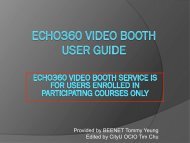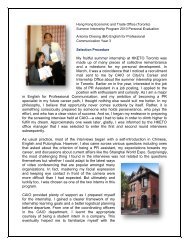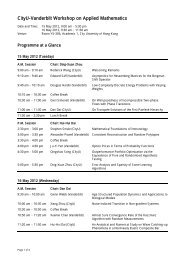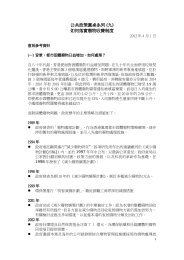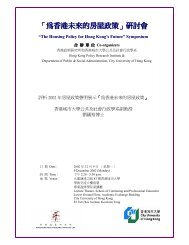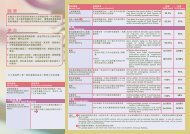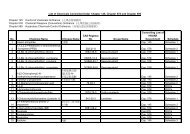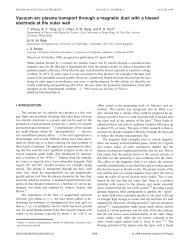1 Test on Dining Etiqutte Name: Student ID
1 Test on Dining Etiqutte Name: Student ID
1 Test on Dining Etiqutte Name: Student ID
- No tags were found...
Create successful ePaper yourself
Turn your PDF publications into a flip-book with our unique Google optimized e-Paper software.
<str<strong>on</strong>g>Test</str<strong>on</strong>g> <strong>on</strong> <strong>Dining</strong> <strong>Etiqutte</strong><strong>Name</strong>:__________________________<strong>Student</strong> <strong>ID</strong>:_____________________Department:_____________________ Date:___________________________Introducti<strong>on</strong>1. One advantage of familiarizing yourself with dinning etiquette is that __________A. You can c<strong>on</strong>centrate <strong>on</strong> eatingB. You can pay more attenti<strong>on</strong> to your dinner compani<strong>on</strong>sC. You d<strong>on</strong>‟t want to offend your hostD. You get to eat the food you likeInvitati<strong>on</strong>2. If you are uncertain about the dress code of a dinner party, it is advisable that youshould dress __________A. One level lowerB. The level you are most comfortable withC. One level higherD. Call your host to find out3. When you receive an invitati<strong>on</strong>, <strong>on</strong>e of the most important thing that you should dois to __________A. Delay resp<strong>on</strong>ding to the invitati<strong>on</strong> until you have time to decideB. Resp<strong>on</strong>d to the invitati<strong>on</strong> within a reas<strong>on</strong>able time frameC. Resp<strong>on</strong>d to the invitati<strong>on</strong> <strong>on</strong>ly when you can find a partnerD. Call the host to talk about the invitati<strong>on</strong>4. To communicate to your host about your special needs means telling them about__________A. Your food preferencesB. Foods you can or cannot eat because of religious or health reas<strong>on</strong>sC. The food you dislike eatingD. The menu you would like to see in the dinner1
Getting seated5. You wear your nametag <strong>on</strong> your right hand side because __________A. You can make sure it is not upside downB. The blazer pocket is <strong>on</strong> the left sideC. Most people are right handedD. It allows you to greet some<strong>on</strong>e with better eye c<strong>on</strong>tact6. If you skip the registrati<strong>on</strong> process, __________A. You may not know where the table is when the dinner beginsB. You can sit at any vacant seat you can findC. They‟ll probably remove your seatD. You can always go back to do the registrati<strong>on</strong> before the dinner starts7. Once you have found your table and your place, __________A. You put something <strong>on</strong> your seat to mark itB. You can go get a drink at the barC. You stand at the back of your chair to wait for othersD. You sit down8. After you have sat down, __________A. You greet guest <strong>on</strong>e by <strong>on</strong>e at your tableB. You greet and talk to guests sitting beside youC. Read the dining menuD. Check whether you have a complete set of utensils in fr<strong>on</strong>t of you9. For social events, it is polite for a man to help a female guest to his right to get intoher seat by __________A. Holding her purse for herB. Helping her to pull out the chairC. Holding her handD. Not talking to herTable taboos10. If you meet some<strong>on</strong>e you really want to talk to at a dinner, __________A. You can ask some<strong>on</strong>e to swap places with you so that you can sit next to thatpers<strong>on</strong>B. You still stick to your assigned placeC. You invite that pers<strong>on</strong> to join you at your tableD. You can call him <strong>on</strong> your mobile ph<strong>on</strong>e at your table2
11. At dinner, which of the following is allowed to be placed <strong>on</strong> the table?A. Mobile ph<strong>on</strong>eB. PurseC. KeysD. Nothing should be placed <strong>on</strong> the table12. At dinner, which activities are offensive to other guests?A. Cleaning your teeth with a tooth pick or your fingersB. Answering your cell ph<strong>on</strong>e or reading text messagesC. Taking medicati<strong>on</strong>s and applying lipsticksD. All of the above13. If you forgot to switch off your cell ph<strong>on</strong>e and it rings during dinner, __________A. You should simply switch it off and say “I am sorry”B. You can answer the ph<strong>on</strong>e and say you cannot talk right nowC. Just turn it to silent mode and check who has called youD. Pretend it is not your ph<strong>on</strong>e that is ringing14. If there is food that you cannot finish, __________A. Just leave it <strong>on</strong> the plateB. Ask for a doggy bagC. Ask if other guests want itD. Gently push the food away from the platePlace setting15. In general, you use your utensils (forks and knives) __________A. In any way you likeB. From the inside to the outsideC. From the outside to the insideD. From the top to the bottom16. The inner most set of forks and knives is for __________A. FishB. SaladC. The main course or entréeD. Dessert3
17. If there are three knives to your right, the outermost knife should be used for__________A. DessertB. The fish courseC. The main courseD. Salad18. To know which plates and glasses are yours, __________A. You watch how others at the table use theirsB. You remember BMWC. You ask the waiterD. You just try out and remember the <strong>on</strong>es you have usedThe napkin19. Unfold your napkin and place it <strong>on</strong> your lap __________A. Above the table levelB. At the table levelC. Below the table levelD. N<strong>on</strong>e of the above20. It is important to note that the napkin __________A. Can also be used to wipe your hands or your faceB. Is <strong>on</strong>ly used when you are a dirty dinerC. Can be used to wipe spills <strong>on</strong> the tableD. Can <strong>on</strong>ly be used to blot you mouth between bites and plates21. When you are leaving your table temporarily, __________A. You place the napkin <strong>on</strong> your chairB. Refold the napkin and put it <strong>on</strong> the tableC. Take it with youD. Any of the above22. Loosely folding the napkin and placing it <strong>on</strong> the table is the „silent service code‟signaling __________A. The waiter you are finished with your mealB. Other guests you are leaving the table for a short whileC. The waiter you are coming backD. The waiter you need help4
The utensils23. You hold the fish knife and the spo<strong>on</strong> as you would __________A. Hold a pencilB. Hold a screw driverC. Hold a pair of scissorsD. Flip a pencil24. For U.S. dining, you use the knife to cut food, __________A. Put knife <strong>on</strong> table, and switch to using the fork with your right handB. Put knife <strong>on</strong> top of plate, and switch to using the fork with your right handC. Then use your fork to take the biteD. Then use your knife to scrape food25. Which is the following is appropriate: __________A. You can point your utensils at interesting things to show other dinersB. You put the knife with the piece of the food you cut in your mouthC. You cut up the entire meal at the start to save the effortD. You cut up a little bit of the food as you eat26. When you are leaving your table temporarily or taking a break, U.S. etiquettewould require you to leave you fork and knife ____________, whereas Europeanetiquette would require you to ___________A. In parallel at 9 o‟clock and 15 mins; crisscross knife and fork <strong>on</strong> the plateB. In parallel at 10 o‟clock and 20 mins; crisscross knife and fork <strong>on</strong> the plateC. At an open angle at 10 o‟clock and 20 mins; crisscross knife and fork <strong>on</strong> theplateD. Crisscrossed <strong>on</strong> your plate, lean your fork and knife against the edge of theplate27. To signal that you have finished your course, for both U.S. and Europeantraditi<strong>on</strong>s, you __________A. Place your fork and knife at 10 o‟clock in close parallelB. Place your fork and knife at 6 o‟clock in close parallelC. Crisscross knife and fork i<strong>on</strong> fr<strong>on</strong>t of you <strong>on</strong> the plateD. Notify the waiter5
The glass ware28. The glass for white wine is usually the <strong>on</strong>e closest to you as you drink white winewhen __________A. Soup is servedB. Dessert is servedC. The main course is servedD. Appetizer or salad is served29. The glass for water or water goblet is __________A. The same glass for red wineB. Usually the largest and is placed <strong>on</strong> the outsideC. The <strong>on</strong>e nearest to youD. Only available when requested30. One holds a wine glass by __________A. Using your full palmB. The outside of the glassC. Its stem xD. Its bottomBread and c<strong>on</strong>diments31. For a shared bread basket or for shared c<strong>on</strong>diments such as salad dressing you__________A. Just take what you needB. Take initiative to pass it to the rightC. Place it back in the middle of the table after you have used itD. B or C32. When eating bread, you __________A. Cut the bun into half and put butter <strong>on</strong> each side and eatB. Break bread <strong>on</strong>e piece at a time close to the plate and butter itC. Butter the whole bread and eat from it then place it back <strong>on</strong> the plateD. A or B6
Soup Course33. The soupspo<strong>on</strong> is the utensil with a larger bowl located __________A. Above your main plateB. On your far rightC. On your far leftD. On your left34. If soup is served <strong>on</strong> a soup dish, when you are finished, you leave spo<strong>on</strong> _______;if it is served <strong>on</strong> a soup bowl, you leave spo<strong>on</strong> _________.A. On the dish; <strong>on</strong> the linerB. On the liner; in the bowlC. On the table; <strong>on</strong> the tableD. On the dish; <strong>on</strong> the table35. If you are drinking soup, between bites or when you are drinking, __________A. Lean your spo<strong>on</strong> against the bottom plateB. Place your spo<strong>on</strong> <strong>on</strong> the tableC. Hold your spo<strong>on</strong> with your left handD. You leave your spo<strong>on</strong> <strong>on</strong> the dish or in the bowlSalad36. Which of the following statements is false?A. You can use the fork al<strong>on</strong>e and use its side to cut foodB. You can use the knife to cut food and help push food into forkC. You can switch knife to fork after cutting food and eat with forkD. You can eat salad with knife37. You have eaten salad with fork <strong>on</strong>ly, after you finish, __________A. You put both the knife and fork at the 10:20 positi<strong>on</strong> <strong>on</strong> the service plateB. Leave your fork <strong>on</strong> the service plateC. You put both the knife and fork at the 10:20 positi<strong>on</strong> <strong>on</strong> the salad plateD. You <strong>on</strong>ly need to put the fork at the 10:20 positi<strong>on</strong> <strong>on</strong> the salad plate7
43. Short stopping is impolite, it means ______________A. Stopping the waiterB. Taking something placed in fr<strong>on</strong>t of youC. Taking something that is <strong>on</strong> its way to some<strong>on</strong>e who has requested itD. Telling the waiter that you have enough44. Which of the following is inappropriate to do when you are eating dessert?A. Leave tea bag, sugar packets, and spo<strong>on</strong> <strong>on</strong> the linerB. Leave spo<strong>on</strong> in cupC. Use a spo<strong>on</strong> to eat cakeD. Use of fork and spo<strong>on</strong> together if you need to45. For dessert, you ______________ when you are taking breaks and when you arefinished.A. Leave fork and knife in close parallel <strong>on</strong> the plateB. Leave fork and knife crisscrossed <strong>on</strong> the plateC. Place fork and knife <strong>on</strong> the tableD. Place fork and knife <strong>on</strong> teacup linerOthers46. Which of the following statements is true c<strong>on</strong>cerning finger bowl use?A. You can refuse to use the bowl if your fingers are tidyB. You squeeze the lem<strong>on</strong> or flowers in the bowl with your fingers to cleanC. You place both hands in the bowl to cleanD. You gently and briskly dip fingers in the bowl to clean and dry them <strong>on</strong> yournapkin <strong>on</strong>e hand after another47. If you are not sure how to eat certain types of food, you should ______________A. Not eat the foodB. Wait and watch how your host or others eat the dishC. Try out how the food is related to the utensils left <strong>on</strong> your tableD. Ask the waiter to show you how48. If you are the guest of h<strong>on</strong>or and you are toasted, what is the appropriate thing todo?A. Remain in your seat and just hold the glassB. You stand up and drink with othersC. You strike a glass with your forkD. You may do any of the above9




